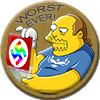This is how I look at it. For this example, a $300,000 house. The 20% down payment is $60,000. 30 year fixed at 3% gives P&I (principal and interest, which is the bulk of your mortgage, not counting homeowners insurance, etc) of $1,011.85. You won't have to pay PMI.
Now, assume you make a 10% downpayment, which is $30,000. Your P&I is now $1,138.33. You saved $30,000 on a down payment, but it costs you 126.48 extra in P&I per month. Now we will have to pay PMI, and assuming a PMI of 1%, that is an extra $225 per month. So by making the 10% down payment, it costs you $351.48 extra per month, so we have to beat that. By the way, $30,000 divided by $351.48 is 85 months or 7 year break even. From what I can tell, you would hit the 80% LTV and terminate PMI at month 60.
So, let's beat $351.48 with a real world example. Instead of doing the 20% down, we will assume we paid 10% down on that house, and use the other 10% ($30,000) to make a better investment.
I'm looking at a beach house, it's $309,000, but for the sake of this argument let's say its $300,000. I'm going to buy it with 10% down for $30,000, and I'm offering their asking price minus $7500 that will go towards closing costs, so it will literally cost me $30,000 out of pocket. The house is a new construction 3 bedroom, 2.5 bath, in a wonderful beach community, on the second row back from the beach, right in the part of town that has a nightlife. There will be monthly fees of approximately $875 (PMI on this loan, property tax, flood/wind insurance, homeowners insurance, utilities, etc). It should earn around $200 per night on AirBNB/VRBO, and average 17 nights of occupancy throughout the year. This gives a gross monthly average income earned from the house of $3,400, minus $1,183.33 P&I, and $875 in fees, coming out to $1386.67 profit per month, or if I'm really lazy and don't want to work the house, pay a property management company 20%, and my monthly net profit is $706.67. Yearly profit of $16,640.03 (without management) or $8,480.03 (with management.) Summer months and holidays demand a premium and your nightly rate will be much higher, and during the winter may be much lower. These are average numbers from comps in the area. So this house is paying it's own mortgage, all of it's bills, and still putting money in your pocket.
So, my point:
Option 1: Pay 20% down payment, save yourself $351.48 per month, but have $60,000 in your house that you can't easily use.
Option 2: Pay 10% down payment for your house, and use the other 10% to purchase a "second home" investment property (mortgage companies will let you do 10% down for a second home) and turn that second home into a cash generating machine. That second home can almost pay the full P&I of your primary home. So by making the lower down payment, you were able to leverage that second 10% of your original down payment and purchase another home that renters will pay the mortgage of, and that home will generate a profit that helps pay off your personal home's mortgage.
I know there are exceptions, but I think it's almost always better to leverage other peoples money to make money. ... And isn't it crazy that the different in P&I between a $30,000 and $60,000 downpayment is barely $100?










